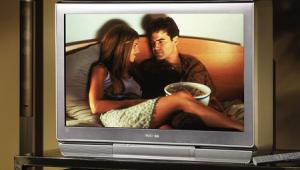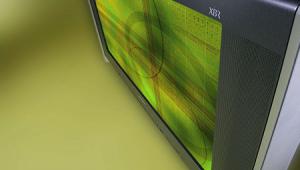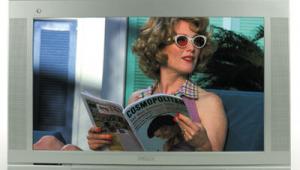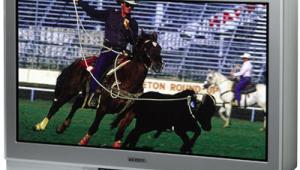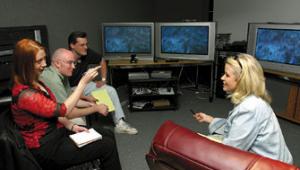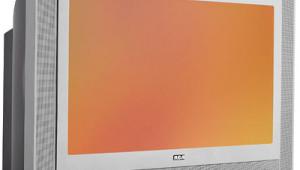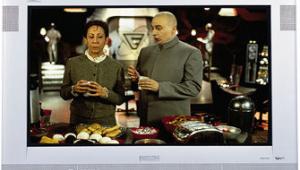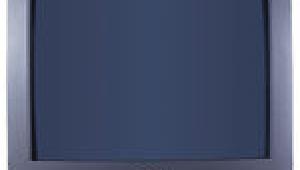RCA D34W20 direct-view high-definition monitor Page 2
Thomson offers several preset picture settings—Movie, Sports, etc.—for different situations. One of them is called Showroom, and that's how the D34W20 was delivered: with its Contrast control cranked up to 75% of maximum. Like every other TV I've reviewed, the D34W20 was way too bright as delivered. Detail in white areas was wholly washed out, and considerable video noise, or snow, was visible in solid dark areas. Scan-velocity modulation, which over-accentuates white areas, could not be turned off.
 Running through the test patterns on the Video Essentials test DVD, I found that the D34W20, also like every other TV I've reviewed, showed considerable "red push": red tones bloomed even when the color level was set correctly. I had to turn the D34W20's Color control down about 30% to tame the reds. This is such an endemic problem that it makes setting the proper color and tint balance almost a meaningless exercise, unless you also have the set professionally calibrated. Fortunately, I had Jamie Wilson, of Overture Ultimate Audio Video in Wilmington, Delaware, to calibrate it for me, and once he was done the RCA was a different machine.
Running through the test patterns on the Video Essentials test DVD, I found that the D34W20, also like every other TV I've reviewed, showed considerable "red push": red tones bloomed even when the color level was set correctly. I had to turn the D34W20's Color control down about 30% to tame the reds. This is such an endemic problem that it makes setting the proper color and tint balance almost a meaningless exercise, unless you also have the set professionally calibrated. Fortunately, I had Jamie Wilson, of Overture Ultimate Audio Video in Wilmington, Delaware, to calibrate it for me, and once he was done the RCA was a different machine.
In fact, it was a pleasure. Pictures were rich, sharp, and detailed, resolution was superb, and colors were vivid and true. And noise, while not wholly absent, was greatly reduced. I watched the DVD of Behind Enemy Lines—quite a nice movie, and a better-than-average transfer. Scenes on the aircraft carrier demonstrated the D34W20's excellent resolution; close-set lines on the aircraft deck were sharp and tight.
I noticed occasional stair-step artifacts, evidence that the D34W20 doesn't offer 3:2 pulldown correction, but the problem was not striking. The line doubler is pretty good, but it was not the best I've seen—artifacts were occasionally apparent. Still, given the range in quality of the scalers built into most DTVs, this one was better than average. If a Faroudja scaler is at the top of a scale running from 0 to 100, the D34W20's scaler ranked about 70. (I've seen a few in the last year that deserved no better than 25-30.) When I flipped my Sony DVP-S9000ES DVD player to progressive-scan output, the problem was reduced, the picture improved by a small degree.
I connected a digital tuner to one of the RCA's component inputs and watched some shows on HD Net, including a 2002 Global basketball game, the U.S. vs. Yugoslavia. I had to reset color and brightness, as I would with any HDTV, but once that was done, the high-definition picture was sharp and highly pleasurable. Not full resolution, of course—no direct-view set can offer that—but thrilling nonetheless. I could pick out individual faces in the seats and see beads of sweat on the players' faces. Not even the best DVD could rival it.
Some sets I've reviewed in recent months did not benefit tremendously from professional color-temperature calibration. I'm thinking of Sony's superb KV-40XBR700 40-inch direct-view HDTV and Panasonic's excellent 50-inch TH-50PHW3 plasma, which emerged from their boxes with settings close enough to the NTSC standard that Jamie Wilson had only to tweak them. The improvement was barely visible.
Not so with the RCA D34W20. Once calibrated, it was a different beast. If you buy one, I highly recommend having it professionally calibrated; once that's done, you'll have an excellent DTV.
Conclusions
The prices of 34-inch, 16:9 TVs have come down a lot. The very first one, by Sony, put on the market in January 1999, cost $8999. The RCA D34W20 and several others now on the market are a quarter of that price. I remember buying a conventional 36-inch Mitsubishi direct-view set 10 years ago that cost as much as the high-definition D34W20. While $2400 is still expensive for a TV, the D34W20 is a most attractive model and well worth the price. With its DVI input, the set will remain up to date for a good number of years, offering a highly pleasing picture all the while.
- Log in or register to post comments
